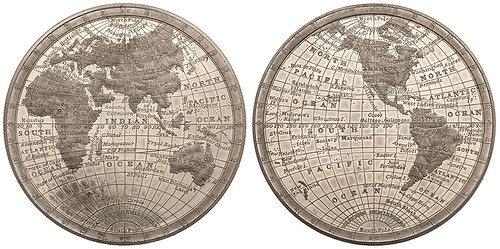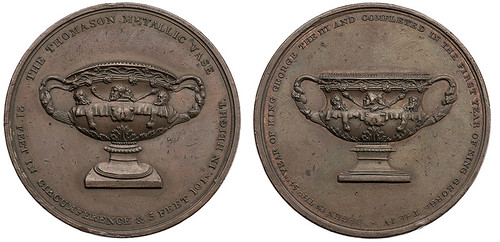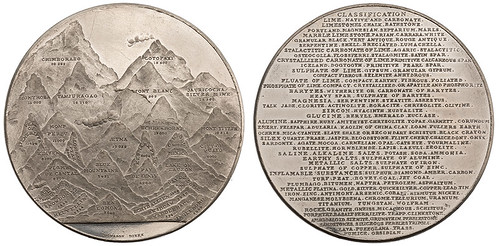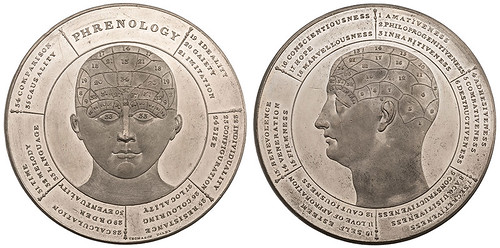
PREV ARTICLE
NEXT ARTICLE
FULL ISSUE
PREV FULL ISSUE
V25 2022 INDEX E-SYLUM ARCHIVE SIR EDWARD THOMASON'S SCIENTIFIC MEDALSA great ANS Pocket Change blog article by John Thomassen examines the very interesting and unusual series of Sir Edward Thomason's scientific medals. Here's an excerpt, but be sure to read the complete article online for much more. -Editor First, a little bit about Sir Edward Thomason. Born in 1769 in Birmingham, England, he was the son of a buckle- and button-maker. His father ran his own manufactory, but despite this (perhaps the elder Thomason knew his son would learn more under the tutelage of another) the younger Thomason was apprenticed at age 16 to the well-known Matthew Boulton at his Soho factory. In 1793, a 24-year-old Edward took over his father's business, and began producing gilt and plated buttons, before moving on to gold- and silver-plated cutlery and flatware, then jewelry and other ornaments.
Before long, Thomason began striking tokens as Matthew Boulton had done years before at his Soho Mint. Because of his apprenticeship under Boulton—and because Boulton had passed in 1809, leaving Thomason's firm in a unique position to dominate this area of the market—Edward ended up striking many thousands of pounds' worth of small change tokens for various firms, most notably Samuel Fereday's ironworks, but also silver coinage for the Douglas Bank on the Isle of Man. These tokens were needed to pay workers their weekly wages, due to the dearth of small change coinage in circulation. And since low-value copper and bronze coinage was not considered In addition to his prowess as a manufacturer, Thomason was also a fairly prolific inventor who went on to patent a number of improved designs, most notably a carriage step that automatically folded up when the carriage door was closed, in addition to design advancements in the world of sword canes, umbrellas, corkscrews, and hearth brushes. Another one of Thomason's projects was the construction of a facsimile in bronze of the famed Warwick Vase—a massive, ancient Roman marble vase discovered at Hadrian's Villa in Tivoli, Italy that now resides at the Burrell Collection in Glasgow, Scotland, but was previously situated at Warwick Castle in Warwick, England. This feat he had commemorated on a bronze medal in 1820, and again in 1829 on additional medals issued in bronze and white metal compositions. All of this brings us to the many medallic series that Thomason also produced to augment his business. These include a series commemorating Napoleon's Peninsular Campaign (20 medals), restrikes of Dassier's Sovereigns of England (36 medals), the aforementioned Parthenon Marbles series (36 medals), his scientific series (16 medals), and perhaps most famously, his monumental biblical series, comprised of a whopping 60 medals. These ambitious series were in addition to single medals issued to commemorate individuals and events (Napoleon, Wellington, the Warwick Vase, completion of the Erie Canal, King George IV, etc.) and were popular during their heyday due to the desire by many middle-class men (and certainly some in the upper class as well) to maintain a proper library as a sign of their upbringing, education, and upward mobility. A proper library could contain not only books and literature, but good furniture, tasteful art, curiosities obtained from travels abroad, and of course, a numismatic and medallic cabinet. Such mass-produced series had their detractors at their time (just as there are detractors today who are disdainful of many modern medallic series) but they remained both desirable to own, and profitable for their manufacturers. Most of Thomason's medals were produced between 1806 and 1830. Unsurprisingly, Thomason's scientific medals generally focused on the areas of science most applicable to him and his business (metallurgy, chemistry) as well as the burgeoning fields of science that were poised to make (or already were making) significant changes in everyday life (steam power, electricity). It isn't entirely clear who Thomason employed to gather the then-current information that made it onto his medals (some are clearly very dated in the year 2022, such as Chimborazo being the highest peak on Earth, and the pseudoscience of phrenology, which many today find particularly comical, especially upon learning that it was taken somewhat seriously in the 19th century) but at least some of this information would have been known and understood by Thomason himself, seeing as it was pertinent to his many lines of business. Likewise, the artists and die sinkers he employed remain in relative obscurity for now, save for some known personnel such as Thomas Halliday.
Thomason received many honors and titles during his lifetime, both for this diplomatic career (which began in 1815) and because he sent precious metal versions of his medallic series to various monarchs and royal families around the globe. In return, he received both knighthoods (including the honorific Lastly, it is worth noting that all 16 scientific medals in the American Numismatic Society's collection were purchased as a complete set in 1947 for a recorded sum of $17.05 from Barney Bluestone's 98th auction catalog, held on October 3 and 4, 1947. The auction listing is pictured below for those interested.
To read the complete article, see:
Wayne Homren, Editor The Numismatic Bibliomania Society is a non-profit organization promoting numismatic literature. See our web site at coinbooks.org. To submit items for publication in The E-Sylum, write to the Editor at this address: whomren@gmail.com To subscribe go to: https://my.binhost.com/lists/listinfo/esylum All Rights Reserved. NBS Home Page Contact the NBS webmaster 
|





